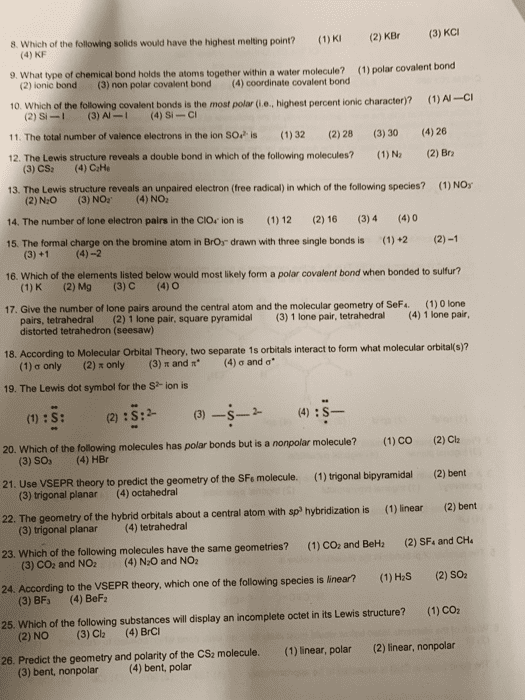CHEM 1300 Lecture Notes - Lecture 11: Valence Bond Theory, Molecular Orbital Theory, Isomer

Lecture 11
Molecular Polarity
●Molecules with dipole moments (µ, mu)
oWe take shape into account
oIt is a numerical measurement of polarity or charge separation within a bond
oPolarity influences reactivity and stability
oUses the same information as BOND Polarity but shows over all dipole spread in a single
molecule
oTries to explain where are the electrons in a single atom of a lewis dot structure
▪We will need EN and formal charge information to be able to use the correct
resonance structure combination to get out correct partial charges/bonds
▪When molecule is placed in an electric field, the measurements will match up
with predicted values
oUse EN and shape to predict
▪Dipoles may cancel out each other due to the structure shape
oTo determine polarity:
▪Draw lewis structure
●Determine e- group shape
▪Check EN and differences between charges
▪add dipole directions
▪check shape and direction for cancelling out
oTrends:
▪180 degree linear structures with the same outer atoms tend to become NON-
POLAR because the shape of the terminal atoms cancel each other out
●Even if the bonds are polar
▪When linear structures contain two different atoms on either side that have
unequal EN the molecule becomes polar
▪If there is a trigonal shape (SN=3, planar), we cannot separate the partial
positive from the partial negative charge, the molecule becomes non-polar
regardless of polarities of bonds
●Will have 1 1/3 partial bonds
▪When we have a lone pair of electrons against a set of number of bonds, the
pone pair will beat out the bonds for the dipole moment direction
●It is known that lone pairs contain higher EN than bonded electrons
●LP on all sides of the plane will cancel each other out just like bonded
electros
oReal life applications
▪Carbon and Silicon
●Carbon has a n <3 so it must follow octect rules and have 4 connecting
bonds in order to be complete
oCan form many different bonds, single, double, triple
o4 single bonds creates a tetrahedral shape
find more resources at oneclass.com
find more resources at oneclass.com
Document Summary
Determine e- group shape: check en and differences between charges, add dipole directions, check shape and direction for cancelling out, trends, 180 degree linear structures with the same outer atoms tend to become non- Polar because the shape of the terminal atoms cancel each other out. Will have 1 1/3 partial bonds: when we have a lone pair of electrons against a set of number of bonds, the pone pair will beat out the bonds for the dipole moment direction. It is known that lone pairs contain higher en than bonded electrons. Lp on all sides of the plane will cancel each other out just like bonded electros: real life applications, carbon and silicon. Silicon is a larger compound with an n>3 so it can break the octet rule and commonly does, can expand octet. Can only form single bonds: hydrocarbons, organic matter, when there are >4 carbons, there will be multiple isomers, isomers vs. resonance structures:


